If you’ve been paying attention, you may have noticed that the folks over at JVC have stepped up their high performance car audio program significantly in the last couple of years. 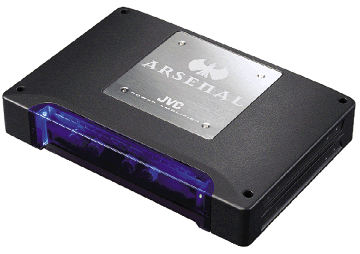 The JVC Arsenal series of products are designed to go head to head with the traditional leading brands in each category, and from what I have seen, are doing a good job at holding their own when compared to the usual suspects. If you were under the impression that a JVC subwoofer amp was about as competitive as the 88 car in Sprint Cup, you’re more out of touch than Dale Jr.’s cousin Tony!
The JVC Arsenal series of products are designed to go head to head with the traditional leading brands in each category, and from what I have seen, are doing a good job at holding their own when compared to the usual suspects. If you were under the impression that a JVC subwoofer amp was about as competitive as the 88 car in Sprint Cup, you’re more out of touch than Dale Jr.’s cousin Tony!
Let’s take a closer look at a new Arsenal series amplifier, the big bad KS-AR9501D. Rated at 500 watts into 4 ohms, and 1,000 and 1,500 watts into 2 and 1 ohm loads respectively, it’s fairly evident that JVC is serious about building some real power! The amp isn’t what you’d call small, nor is it a lightweight. And when you’re building $649.95 (USD) car audio amplifiers that can have their output measured in horsepower, that’s a good thing (1HP = 745.7 Watts). Features
The KS-AR9501D measures about 14.2” x 9.7” x 2.4”, and weighs over 11 pounds. Much of that weight comes from a large and thick cast aluminum heat sink that’s required to dissipate the amount of heat generated and keep the Arsenal amp running cool and reliably. From a cosmetic perspective the big JVC flagship is a little on the plain side, but some have commented that it just looks serious. At any rate, the amp uses a simple and smooth design, finished in a powdercoating that’s a medium-dark shade of charcoal. In the center of the top surface of the heatsink is a large square badge of brushed aluminum retained with 4 hex-head chrome screws. Of course I took the screws out to see if anything was hiding under there, and while there’s nothing under it, I soon realized they made it removable and square so it could be rotated in 90 degree increments to always be facing “the right direction” regardless of how the amp was mounted. Thoughtful stuff like this from JVC… nice! And there’s more.
The Arsenal amp is laid out in a way that puts all the wiring, power, speaker and signal, all on one side of the chassis, and all of the controls on the opposite side. This is really handy when doing the install, because having all the wiring on one side makes things easier to hide and trim out. The controls themselves are also a departure from the normal.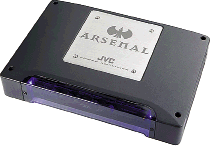 Instead of the usual tiny little pots that require a small screwdriver to adjust the pot you’re looking for, the Arsenal amplifier celebrates its control functions. All of the control settings, gain, crossover, subsonic filter, bass EQ, and phase are recessed behind an L-shaped smoked polycarbonate cover. You remove the cover with two hex head machine screws, and behind it, instead of tiny little pots and switches; you get actual real control knobs, big enough to turn easily with your fingers. The controls themselves are nicely weighted and have a quality feel to them, and the large diameter knobs make very small incremental adjustments much easier to make. I think it’s a cool idea, although at first blush, having four big knobs on an amplifier did look very unusual.
Instead of the usual tiny little pots that require a small screwdriver to adjust the pot you’re looking for, the Arsenal amplifier celebrates its control functions. All of the control settings, gain, crossover, subsonic filter, bass EQ, and phase are recessed behind an L-shaped smoked polycarbonate cover. You remove the cover with two hex head machine screws, and behind it, instead of tiny little pots and switches; you get actual real control knobs, big enough to turn easily with your fingers. The controls themselves are nicely weighted and have a quality feel to them, and the large diameter knobs make very small incremental adjustments much easier to make. I think it’s a cool idea, although at first blush, having four big knobs on an amplifier did look very unusual.
And the features still don’t end there, either. Not only has JVC decided to build big amps, they recognize that even a really big amp isn’t always enough, so they have made the KS-AR9501D strappable to a second one. They even include a special RCA output connection that allows the Master amp in the pair to provide all the adjustment and control for both amps. A regular RCA cable can be used for the connection, no special cable’s required. Again, it’s pretty obvious that someone at JVC has been doing their homework. Also provided are the usual RCA outputs to feed the input signal to additional amplifiers as needed.
Read on for the Results
The KS-AR9501D measures about 14.2” x 9.7” x 2.4”, and weighs over 11 pounds. Much of that weight comes from a large and thick cast aluminum heat sink that’s required to dissipate the amount of heat generated and keep the Arsenal amp running cool and reliably. From a cosmetic perspective the big JVC flagship is a little on the plain side, but some have commented that it just looks serious. At any rate, the amp uses a simple and smooth design, finished in a powdercoating that’s a medium-dark shade of charcoal. In the center of the top surface of the heatsink is a large square badge of brushed aluminum retained with 4 hex-head chrome screws. Of course I took the screws out to see if anything was hiding under there, and while there’s nothing under it, I soon realized they made it removable and square so it could be rotated in 90 degree increments to always be facing “the right direction” regardless of how the amp was mounted. Thoughtful stuff like this from JVC… nice! And there’s more.
The Arsenal amp is laid out in a way that puts all the wiring, power, speaker and signal, all on one side of the chassis, and all of the controls on the opposite side. This is really handy when doing the install, because having all the wiring on one side makes things easier to hide and trim out. The controls themselves are also a departure from the normal.
 Instead of the usual tiny little pots that require a small screwdriver to adjust the pot you’re looking for, the Arsenal amplifier celebrates its control functions. All of the control settings, gain, crossover, subsonic filter, bass EQ, and phase are recessed behind an L-shaped smoked polycarbonate cover. You remove the cover with two hex head machine screws, and behind it, instead of tiny little pots and switches; you get actual real control knobs, big enough to turn easily with your fingers. The controls themselves are nicely weighted and have a quality feel to them, and the large diameter knobs make very small incremental adjustments much easier to make. I think it’s a cool idea, although at first blush, having four big knobs on an amplifier did look very unusual.
Instead of the usual tiny little pots that require a small screwdriver to adjust the pot you’re looking for, the Arsenal amplifier celebrates its control functions. All of the control settings, gain, crossover, subsonic filter, bass EQ, and phase are recessed behind an L-shaped smoked polycarbonate cover. You remove the cover with two hex head machine screws, and behind it, instead of tiny little pots and switches; you get actual real control knobs, big enough to turn easily with your fingers. The controls themselves are nicely weighted and have a quality feel to them, and the large diameter knobs make very small incremental adjustments much easier to make. I think it’s a cool idea, although at first blush, having four big knobs on an amplifier did look very unusual. And the features still don’t end there, either. Not only has JVC decided to build big amps, they recognize that even a really big amp isn’t always enough, so they have made the KS-AR9501D strappable to a second one. They even include a special RCA output connection that allows the Master amp in the pair to provide all the adjustment and control for both amps. A regular RCA cable can be used for the connection, no special cable’s required. Again, it’s pretty obvious that someone at JVC has been doing their homework. Also provided are the usual RCA outputs to feed the input signal to additional amplifiers as needed.
Read on for the Results
Related Articles
 Kenwood DNR1007XR Head Unit
Kenwood DNR1007XR Head Unit
The KENWOOD eXcelon Reference DNR1007XR navigation receiver has built-in Garmin Navigation, is both Apple CarPlay and Android Auto ready via wired or...
 PASMAG Unboxing: JVC KV-DR305W Dashboard Camera
PASMAG Unboxing: JVC KV-DR305W Dashboard Camera
We unbox the JVC KV-DR305W 1920x1080p Full HD Recording Dash Cam featuring integrated GPS, 2.7" LCD screen, built-in Wi-Fi, 3-axis g-force sensor,...
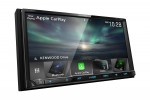 Kenwood eXcelon DMX706S Digital Multimedia Receiver
Kenwood eXcelon DMX706S Digital Multimedia Receiver
The Kenwood eXcelon DMX706S Digital Multimedia Receiver features a 6.95" large WVGA touch screen display, and it's Apple CarPlay and Android Auto...
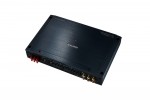 Kenwood eXcelon XR901-5 5-Channel Amplifier
Kenwood eXcelon XR901-5 5-Channel Amplifier
The Kenwood eXcelon XR901-5 5 Channel Class D Power Amplifier built with High Performance Capacitors and Inductors. Hi-Res Audio Capable for Rich and...
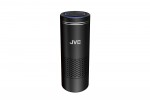 JVC KS-GA100 Air Purifier
JVC KS-GA100 Air Purifier
The JVC KS-GA100 air purifier with HEPA Filter has 3-stage filtration, motion activated controls, and is portable enough for the car cup holder....
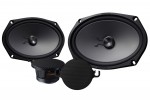 Kenwood eXcelon KFC-XP6902C Component Speakers
Kenwood eXcelon KFC-XP6902C Component Speakers
The Kenwood eXcelon KFC-XP6902C 6x9" plus 2 3/4" Component Speaker System is the industry’s best solution for a 6x9” door speaker and vehicle specific...




